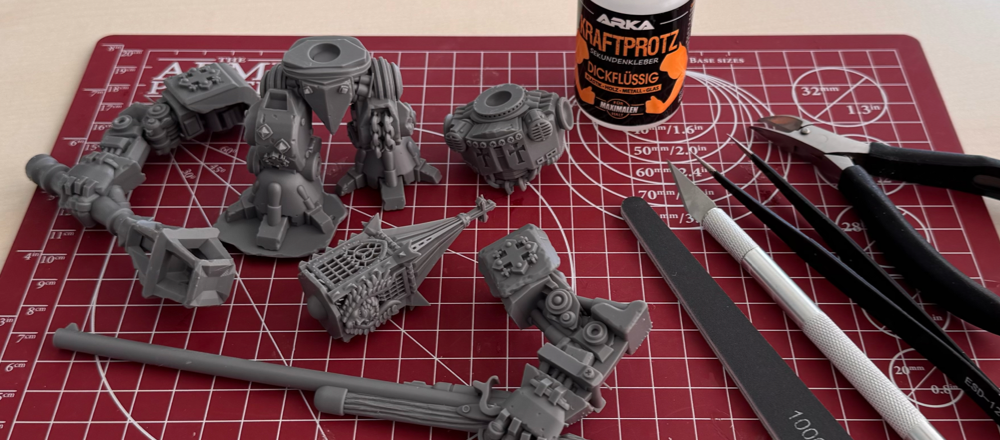
Resin-Printed Miniatures: The Ultimate Preparation Guide
Share
Welcome, hobby friends! 🎨🛠️
You have just received your new, highly detailed resin miniatures from us – congratulations! 🎉 Even though we ship your minis already cleaned twice and fully cured, we want to provide you with additional tips and safety guidelines to ensure your miniatures are optimally prepared—whether for gaming or display.
1️⃣ Cleaning: The final touch for a clean base
Although our miniatures are professionally cleaned, fine dust residues or minimal resin particles may still be present on the surface. A gentle additional cleaning improves paint adhesion.
How to do it:
Tools: Use a soft brush (e.g., toothbrush, makeup brush).
Method: Clean the miniature with lukewarm water and mild soap. Do not soak it for too long, as this may cause damage.
Drying: Let the miniature air dry for at least 6 hours or overnight. Alternatively, you can use a hairdryer with a cool airflow (no heat).
2️⃣ Removing supports & post-processing
Although we remove all major support structures, small residues or fine "nubs" may remain. These should be carefully removed before painting.
How to do it:
Inspection: Thoroughly check the miniature for small support residues.
Removal: Carefully cut them off using a hobby or scalpel knife. For very fine details, tweezers may also be helpful.
Finishing: Smooth sharp edges with fine sandpaper (800–1000 grit) or a mini-file.
Safety: Always wear an FFP2 mask while sanding, and if possible, use an extraction system or dust filter to minimize fine resin dust.
3️⃣ Gluing: The right adhesive for perfect hold
Resin miniatures require special gluing techniques, as regular plastic model glue often does not adhere well. For heavy parts, pinning can also improve long-term stability.
How to do it:
Adhesive: Use high-quality super glue (cyanoacrylate) for a strong bond.
Preparation: Lightly score the bonding surfaces with a hobby knife to improve adhesion.
Curing: A slightly damp surface can speed up the glue's curing process, but make sure the parts are not too wet.
Fixing: Hold the parts together for a few seconds until the glue has set.
Safety tip:
Avoid direct contact with the glue – it can bond skin quickly! If a finger accidentally comes into contact, do not pull it off forcefully; instead, carefully dissolve the glue with warm soapy water or acetone.
4️⃣ Priming & Painting: The best paints for resin
Resin has different surface properties than plastic or metal. Therefore, the right primer is crucial for long-lasting paint adhesion.
Priming tips:
Drying: Ensure the miniature is completely dry before priming.
Product choice: Avoid water-based acrylic primers, as they often adhere poorly or may react with the resin over time. Instead, use solvent-based spray primers such as Vallejo Surface Primer, Army Painter Spray, or Citadel Sprays.
Application: For alternative methods like brush priming, test on a small area first to check compatibility with your resin.
Ventilation: Work in a well-ventilated area to safely dissipate solvent fumes.
5️⃣ Caution: What to do if you find suspicious resin residues?
Our miniatures are fully cured, but if you discover liquid or sticky residues, act immediately.
How to do it:
First measure: Place the affected miniature immediately in an airtight plastic bag or container to prevent further contact. Ideally, place it in a well-ventilated area and direct sunlight. Resin cures through UV exposure. Keep it away from children and pets.
Avoid skin contact: If resin comes into contact with your skin, wash it immediately and thoroughly with soap and water.
Documentation: If possible, take photos of the affected area to provide us with a detailed problem description.
Contact: Reach out to our customer service directly – we are happy to help!
Conclusion: The right preparation for the perfect miniature
By following these steps, you can ensure that your resin miniatures are perfectly prepared for gaming or display:
Cleaning: Use a soft brush and mild soap without fully submerging the miniature in water.
Removing supports: Check for small residues and smooth sharp edges—possibly with the help of tweezers.
Gluing: Use high-quality super glue, roughen the bonding surfaces slightly, and hold the parts together.
Priming: Use solvent-based spray primers—always in a well-ventilated area.
Safety: Always wear protective gear (gloves, FFP2 mask, possibly dust extraction) and document any resin irregularities.
Now nothing stands in the way of your hobby fun! Enjoy building, painting, and of course, playing. 🛡️🎲🔥
Do you have questions or need support?
We at Wargame Wonders are always here for you! Just write to us – we are happy to help.
Happy Wargaming! 🏆
